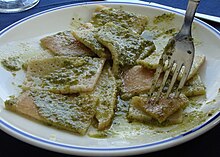
Back تيستارولي Arabic تيستارولى ARZ Testaroli Spanish Testaroli French Testaroli Italian Testaroli JV Тестароли Macedonian Тестароли Russian Testaroli Uzbek
 | |
| Type | Pasta |
|---|---|
| Place of origin | |
| Serving temperature | Hot |
| Main ingredients | Flour, water |
| Ingredients generally used | Salt |
| Variations | Falsi testaroli al ragù |
| Other information | May be served with pesto sauce, olive oil, pecorino, Parmesan or garlic |
Testaroli, sometimes referred to as testarolo,[1] is a type of thin spongy pasta or bread in Italian cuisine that is prepared in circular sheets using water, flour and salt, which is then sliced into diamond or rectangular shapes. A common dish in the Lunigiana region and historical territory of Italy, it is an ancient pasta originating from the Etruscan civilization of Italy. Testaroli has been described as "the earliest recorded pasta". It is also a native dish of the southern Liguria and northern Tuscany regions of Italy.
Testaroli is prepared from a batter that is cooked on a hot flat surface, after which it may be consumed. It is traditionally cooked on a testo, a flat terracotta or cast iron cooking surface from which the food's name is derived. It is sometimes cooked further in boiling water and then served. Testaroli is sometimes referred to as a bread, and is sometimes referred to as a crêpe. It may be dressed with pesto sauce or other ingredients such as olive oil, pecorino, Parmesan, and garlic. Falsi testaroli al ragù is a similar dish, prepared using sliced pasta dough and a ragù sauce.
© MMXXIII Rich X Search. We shall prevail. All rights reserved. Rich X Search